Dog Breeds: Other breeds
If you want to buy a book, clicking on the book cover
will take you directly to that book on the Amazon.co.uk web site.
See also:
 Dogs:
Breed profiles and breed books Dogs:
Breed profiles and breed books
 Dogs:
Health and Nutrition Dogs:
Health and Nutrition
 Dogs:
General Dogs:
General
 Dogs:
Origins, canine evolution and wolves Dogs:
Origins, canine evolution and wolves
 Training, puppy and adult dog good manners Training, puppy and adult dog good manners
 Advanced training, including gundog training Advanced training, including gundog training
 Fiction
and biography relating to dogs Fiction
and biography relating to dogs
 Click
here for other breeds on stamps Click
here for other breeds on stamps
|
Click on the above image to see more
stamps featuring dogs
|
General overview
The dogs we have put in this category don't easily fit elsewhere, though
some have been classified in other systems. Basenjis, for example, are called
'hounds' by the Kennel Club, yet they share some characteristics with spitz
dogs, and can be more of a handful than the average sighthound. Dobermanns,
Rhodesian Ridgebacks and Rottweilers are sometimes used as guard dogs, but
they are versatile dogs which can do more than guard. Dobes and Rotties have
also been portrayed in unhelpful ways - Dobes as outdoor dogs in movies, when
they would much rather be on a warm sofa with their owners, and Rottweilers
as synonymous with aggression, when a well-bred and well-trained Rottie can
be a very gentle dog. These three breeds do have a potential for aggression,
but it's safer to teach them to be friendly with people. They will tend to
be intimidating to anyone who enters your property without your being with
the dog, and it's preferable that they don't bite people you don't want them
to, especially children. Shar Pei also need careful socialization, due to
their potential for aggression, though well-bred, well-socialized Shar Pei
can be gentle, calm dogs.
Dalmations are very elegant dogs, and are sometimes taken on by people who
see them as Labradors with spots...they aren't! They tend to be much less
biddable than Labradors, need a lot of exercise and attention, and can't always
be trusted to behave off leash.
Why Poodles in this company? Poodles are wonderful dogs, generally healthy,
don't shed, easily trained, and relatively well behaved. They come in different
sizes to suit the different strengths we acquire and lose as we become adults
then grow older. And what do we do for them? Some people turn them into fashion
accessories. A book on poodle clipping is included, but, please, if you get
one of these versatile dogs, remember that they like retrieving and doing
other doggy things. If you have to show them, please give them some fun too,
even if it's just lots of games indoors where their coats won't get muddy
or damaged. Standard poodles are generally more reliable in terms of temperament,
but often smaller poodles are just bored rather than poorly bred. They are
all dog, and need to go out and get those coats good and muddy now and then,
like any self-respecting dog.
Hungarian Pulis are also often seen in terms of their coats, and, like poodles,
they have a lot more to offer than their looks. They are herders, so a little
more demanding than a Poodle, but can be very rewarding for people who want
an active dog for agility and other sports. Italian Spinones are gundogs with
a touch of hound in their character, not very well known in the UK, and worthy
of more recognition. Schnauzers are very versatile, intelligent dogs, though
not always easy to train because they are pushy dogs. They too are often seen
in terms of their haircuts, but have far more to offer.
Many of these breeds attract owners because of their looks, but it's well
worth getting to know the dog underneath. It can be an eye-opener to spend
the day with one, if you are interested in the breed for your next dog.
Good manners are best taught from puppyhood, because it's easier, but adult
rescue dogs can still learn fast. The best time to teach good manners to a
rescue dog is as soon as the dog arrives. That is when the dog is watching
you to learn what the rules are. It's tempting to spoil the dog a bit, because
you feel sorry for him or her. But it's kinder in the long run to let the
dog know gently and firmly what you consider to be appropriate behaviour.
Rescue centres usually have their own behaviourists and provide ongoing help
for adopters. Gwen Bailey's 'The Rescue Dog' is also full of good advice.
Breed Profiles

Click on the cover above
to go to this book
at Amazon.co.uk
|

Basenji Out of Africa (The Pure-breed Series)
Susan Coe
Doral Publishing, Inc
ISBN: 0944875696
Basenjis are a very old breed, used as a hunting dog in Africa. They
are sometimes classed as hounds, but they have a number of special characteristics
that make them stand out. They don't bark, but they do have special
Basenji noises when they are happy, and when they are sad and lonely,
so they can annoy the neighbours when you leave them alone. In fact
they can annoy neighbours more than most dogs, because the sound they
make doesn't appear to have come from a dog, rather from a very unhappy
human! They can also be good watchdogs, alerting their owners to strangers
at the door. Basenjis are sometimes wary of strangers, and need ongoing
socialization. They like to chase cats and other small animals, because
they are hunting dogs, so can't always be trusted off the lead, and
they can escape from gardens despite fences that would deter most dogs
of their size. They can get on very well with older children, especially
if the Basenjis have grown up knowing children from when they were puppies,
and the children manage to understand the Basenji's mind, but Basenjis
can be a bit too pushy and lively for families with younger children.
It's a good idea to bring children into the training programme, so that
these dogs have consistency in how house rules are applied to them,
and so they learn to respect the children.
Dog aggression can be a problem with Basenjis, especially against other
dogs of the same sex though they often get on well with other Basenjis
in a household, and can get on well with some breeds. Basenjis are also
notorious chewers, a trait which can persist into adulthood, so you
may need to dog-proof your home more than usual, and confine your Basenji
to parts that you don't mind being chewed. Behavioural problems have
often been reported in Basenjis, and this may be because they look deceptive.
They are elegant, small to medium dogs, it is difficult to believe there
is so much willpower packed in such a small body.
Training Basenjis is similar to training spitz dogs; Basenjis are not
dumb, they just don't always want to do what you want them to, and they
need firm ground rules from when they are pups, because they can be
so pushy. This should go beyond the usual bite inhibition - Basenjis
are very good at getting their own way, and if you give in too easily,
they are bright little dogs and will take advantage of this. They also
need active lives, or they can get bored and chew, or otherwise annoy
their owners. Providing lots of chew toys, and Kongs smeared with peanut
butter can help.
Generally, these are active, healthy dogs, but they do have common
health problems which include Fanconi syndrome, anaemia, eye trouble,
digestive problems, and hypothyroidism.
Why get a Basenji with all these problems? There is a magic about this
breed. They are intelligent, active and alert dogs, which are exceptionally
good looking. They are also very clean dogs. They are easy to housetrain
and tend not to shed or smell much, though their coats are thin, so
they do need protection in winter, and they tend not to want to spend
long outside when it's wet and cold. They are quite small, so don't
take up much space or eat you out of house and home. Basenji bitches
also have just one season a year, whereas most dogs have two. If you
choose your pup carefully, ignoring the most pushy one - unless you
like especially strong-willed dogs - you can have a delightful companion
which is unique in the dog world.
New Basenji stock has been imported from Africa to the US, and this
book examines the influence of these imports, as well as telling you
a lot about the breed. Basenjis are truly unique, and originated in
just one small area in Africa. The book gives you a thorough history
of the breed, as well as a clear description of its unique characteristics,
with explanations of why they have developed, and why Basenjis are different.
The book is both well-researched and a pleasure to read. It's of interest
to people who study canine evolution, as well as the breed's many fans.
 Top
of page Top
of page
|

Click on the cover above
to go to this book
at Amazon.co.uk
|

Basenjis
Jack Shafer, Bob Mankey
TFH Publications
ISBN: 0793823900
This book is a good, inexpensive, guide to Basenjis, which gives a
very clear idea of the breed. There's help with training as well as
general care. It's both accurate and well-illustrated.
 Top of page Top of page
|
|

Basenji (Pet Love)
Juliette Cunliffe
Interpet Publishing
ISBN: 1903098971
Juliette Cunliffe has written an up-to-date account of the history
of Basenjis, and gives good advice on their general care. This is well
written and easy to follow, and is a useful reference book for a new
Basenji owner.
 Top
of page Top
of page
|
|

The Complete Basenji (Book of the Breed)
Elspet Ford
Ringpress Books
ISBN: 094895597X
There is a lot of useful advice on Basenji health issues in this book,
as well as an interesting account of the breed's history. It is also
well illustrated, with fine photos of wonderful Basenjis.
 Top of page Top of page
|
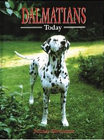
Click on the cover above
to go to this book
at Amazon.co.uk
|

Dalmations Today: Book of the Breed
Patches Silverstone
Ringpress Books Ltd; 1st edition (1 May 1997)
ISBN-10: 1860540325
ISBN-13: 978-1860540325
Dalmations are delightful dogs for people who have the energy to keep up with them, and who are skilled at training. They are sensitive, and can switch off if trained too roughly, but can also be motivated by their desire to play. They are very active dogs, which take a while to mature, so they can be too boisterous for some children. Boisterous Dalmations have been known to knock over adults, just by giving a friendly greeting. Exercise is important, since Dalmations that don't get to run around enough can become overactive, destructive in the home, and generally difficult to live with. Dalmations aren't dogs to leave alone for long periods. They also need training from puppyhood, especially in learning not to jump up, and they don't take to training as easily as, say, Labrador Retrievers, but do learn, so long as their owners are persistent. Well-trained Dalmations are good companions for children, though they are a bit strong and lively for children to take out for walks, and tend to be too lively indoors for small children.
Some Dalmations can be dog-aggressive, and entire males may get into spats with other entire males they meet on walks, but generally Dalmations get on well with other dogs, so long as they are carefully socialized. They are good watchdogs, giving serious barks to alert their owners, but not usually over-barky. They are usually sociable with visitors, so aren't good guard dogs. Dalmations shed a fair amount, and the short hairs can be difficult to dislodge from clothes. They don't usually have a strong doggy smell, so long as they get out enough.
Dalmations can suffer from cold in winter, and may benefit from a coat. Common health problems include inherited deafness, food allergies showing as skin disorders, and high levels of uric acid leading to urinary stones. They should not be fed pulses, especially lentils, or offal, nor should they be given aspirin. It's especially important that Dalmations always have access to water, and kibble should be soaked rather than given dry.
This Book of the Breed was written by Patches Silverstone, who has been involved in Dalmations since 1971, and was on the Committee of the British Dalmatian Club (BDC) for nearly 20 years. The book looks at the origins of the Dalmatian, and its role as companion and show dog. There's help with choosing and caring for a new puppy, including training and socialisation. The book also covers exercise and nutrition. There is useful information on breeding and genetics, with a particular focus on deafness, a condition associated with Dalmatians. Dalmation lovers will drool over the illustrations.
 Top
of page Top
of page
|
|

Pet Owner's Guide to the Dobermann
Clive Evans, Nancy Evans
Ringpress Books
ISBN: 1860541143
Dobermann Pinschers are high-energy, muscly, elegant dogs which often
appear in movies in the role of dangerous guard dogs. Their ears tend
to be cropped in the US, so they stick up and are pointy, while they
are left uncropped in the UK, giving a much more natural appearance.
Dobes have performed a wide range of roles as working dogs, so are difficult
to classify. Originally developed as guard dogs, they have also been
used a tracker dogs, and even herders, and dogs of different types went
into creating the breed. Generally, they perform the role of guard dog
without any training, in fact it is best to socialize them as much as
possible, both with people and with other dogs. A Dobermann will be
enough of a deterrent to any intruder, just by standing there and giving
a deep 'Woof'. Attempts to encourage the dog to be wary of humans could
result in aggression at a time when you want the dog to be friendly.
This breed varies a lot in terms of temperament, so it is especially
important to try to meet the parents of pups you are interested in,
and to ask the breeder what sort of temperament they are breeding for.
Some Dobermanns can be very shy and sensitive, which affects how you
train them, and they may be more inclined to be snappy out of fear,
especially if bite inhibition has not been thoroughly taught. Other
Dobes are bolder, or more relaxed by nature. Despite the image of a
Dobe as an outdoor guard dog, put across in movies, Dobermanns do not
do well in this role. They like being with their owners, and were bred
to work closely with people, rather than live outside on their own.
They also like comfort, and don't handle cold well.
Training can be a challenge. Dobes are intelligent, and can get bored
if not enough effort is made to motivate them. They also need consistency
right from the start. Dobermann pups should be told how you want them
to behave as adults, because it's much easier to affect their long-term
behaviour while they are little than when they are big, strong dogs,
already set in their ways. Dobes do like attention, however, so you
can motivate them with praise, and deter unwanted behaviour by withdrawing
attention. The more sensitive individuals can also switch off if shouted
at. Socialization with people is important, especially with the shyer
Dobes, and because a Dobermann can easily frighten those who don't know
dogs well, just by barking. Use a dressing up box and get your Dobe
used to seeing people in funny hats, with walking sticks, big satchel-bags
like delivery boys ... the works!
Dobermanns are versatile dogs, so it's well worth putting a lot of
effort into training them. A well-trained Dobermann responds fast to
his handler's commands, and is a joy to work with. They have performed
a wide range of roles, such as search and rescue, and therapy dogs,
and have performed well in obedience competitions. They need to be kept
active, though they are happy to play games indoors too, and enjoy sniffer
dog games, like finding titbits you secrete round the room, or hidden
bits of cloth impregnated with good smells.
Dobermanns are generally good with children, so long as they have been
used to them from puppyhood. Young Dobes can be a bit large and bouncy
for smaller children, though many older Dobermanns are well-behaved
enough to be safe around small children and frail elderly people. Dobermanns
also need to be socialized with other dogs while they are pups. They
will need fairly robust puppy playmates, preferably of calmer breeds,
to tone down their exuberant playing style. Some Dobermanns can become
dog aggressive as they get older, but generally, well-socialized Dobes
get on well with other dogs. They are great chewers, and need legitimate
chew objects. Dobes don't need much grooming, and aren't especially
bad shedders. Their colour also means that their hairs aren't as noticeable
as with lighter-coloured breed.
A disadvantage of this breed is that it can suffer from a wide range
of health problems, including cancer, dilated cardiomyopathy (a heart
disorder), Wobbler's syndrome (cervical spondylitis), Von Willebrand's
disease (blood disorder), juvenile diabetes, hypothyroidism, bloat,
hip dysplasia, renal dysplasia, and spay-related incontinence. It's
especially well worth checking the longevity of the ancestors of any
pup of this breed that you are interested in. Some Dobermanns can live
to a good age, but all too often their lives are cut short.
The Evans book is a good introduction to the breed for novices, though
it is too short to be of great interest to experienced owners. It is,
however, an inexpensive book, and is good value.
 Top
of page Top
of page
|
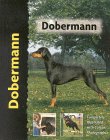
Click on the cover above
to go to this book
at Amazon.co.uk
|

Dobermann
Lou-Ann Cloidt
Interpet Publishing
ISBN: 1902389298
This book is a good introductory guide to Dobermanns, which covers
the basics, and gives you an account of the breed's history. There's
advice on choosing a pup, and basic care and training. The book is well
illustrated, and the photos will please lovers of this elegant breed.
There's not much in this book that experienced owners are unlikely to
know, though it's a little more in-depth than the Evans guide.
 Top of page Top of page
|

Click on the cover above
to go to this book
at Amazon.co.uk
|

Hungarian Puli
Ann Arch
Interpet Publishing
ISBN: 1903098521
Hungarian Pulis are not very well known in the UK, and stand out for
their unusual appearance. They have long, black, 'dreadlocks'. They
are often bought to be show dogs, because they look so striking, but
they are herders, and are happiest when they are active. Pulis can develop
behavioural problems if they aren't given enough to do. They are very
good agility dogs, and also perform well in obedience competitions.
Pulis are wonderful dogs for people who want an active dog they can
do agility with, and who are prepared to put training time in. These
dogs respond very well to training, learning fast. They are happiest
when kept busy, and their vices are typical of herding breeds - nipping
and barking as part of their herding behaviour. Puli pups do need special
attention with bite inhibition, and socialization should be ongoing,
since Pulis can be a little wary of strangers, which usually means being
barky. They are good watchdogs for this reason, since they will alert
their owners to strangers. They are not especially good guard dogs,
since they don't look very fearsome. There is a larger Hungarian relative
of the Puli with a similar coat, the Komondor, which was used for flock
guarding, and which makes a better guard dog.
Are they good with children? This depends. They can be a little nippy,
and younger children might be tempted to pull on their cords, so they
are better suited to families with older children, who respect them.
Pulis can be a bit pushy, and children need to be brought into training
programmes so that everyone teaches the dog the same house rules. They
can also knock over smaller children, because they are so active, though
this is less of a risk than with a larger active dog like a Bearded
Collie.
One of the attractions of Hungarian Pulis is that they are generally
very healthy. Hip dysplasia, cataracts, and urinary stones can affect
some individuals, but generally this breed is long-lived, and stays
active all its life. It's especially important to give them access to
water, and moistened dry food is better than just dry, so their urine
isn't too concentrated. Asprin is also not a good idea for these dogs.
A Puli's coat reaches the ground when full-grown, which takes some
two to three years. Caring for the coat involves creating cords from
matted underfur and the longer coarse hairs. Each cord has to be created
by the owner. The coat doesn't need much care after the cords have formed,
but it takes a long time to dry when it gets wet. Owners who just love
the Puli's personality and don't want to show their dog could think
of (gasp) trimming the coat just a little, so it isn't an encumbrance,
picking up mud everywhere and taking hours to dry. It's human culture
that has decided on the way a Puli wears its coat, as is true with the
Poodle, and these dogs have too much to offer to be seen simply in terms
of their coats.
Ann Arch's book is a very good, up-to-date introduction to the breed,
which should interest all Puli owners. It's accessible enough for novice
owners, and has enough detail to interest experienced owners. The book
also has some lovely pictures of Pulis.
 Top
of page Top
of page
|
|

The Italian Spinone (World of Dogs)
Carolyn Fry
Kingdom Books
ISBN: 1852790849
Italian Spinones are gundogs with white wiry hair, sometimes with
brownish patches, which are not very well known in the UK. They are
quite big - just a little bit bigger than Golden Retrievers. They generally
have nice temperaments so are well worth considering as family pets
for active people who like the outdoors. Italian Spinones are not specialist
dogs, in that they are able to point and retrieve, and bear some resemblance
to hounds, being more independent than most gundogs. They are a very
old breed which was revived in modern times.
These dogs learn fast, and enjoy working with their owners, though
they are not always obedient. They can switch off if shouted at or treated
roughly, since they are sensitive to their owner's moods, and they need
to be motivated, far more than a Golden or a Labrador Retriever. They
also like being playful, as well as working. Some sort of daily activity
is important. Walks are preferable, though retrieve games in the garden
come a good second best. These dogs are good at escaping, since they
jump well, and they are more likely to want to go walkabout if they
don't get enough exercise. They enjoy swimming, and can tolerate bad
weather conditions. They aren't especially fast movers, but have great
stamina. They also usually get on well with other dogs, and people they
meet, including strangers, and are less likely to indulge in jumping
up at strangers than some breeds, so they are good walking companions.
Italian Spinones do need to be socialized, since otherwise they can
be a little shy with people they don't know. They are generally not
at all shy with their human family, often seeking to be lap dogs, which
can be uncomfortable.
Young dogs of this breed can be a little bouncy, but generally they
are very good companions for children, since Spinones usually grow up
to be calm, relaxed and patient dogs. No dog can be taken for granted
with children, so supervision is always needed, and children need to
learn not to tease dogs. However, this breed is more reliable than most.
They are also likely to be well-behaved with visiting children, and
get on well with other dogs in multi-dog households.
This breed is likely to track mud into your home and shake its wet
coat near your walls. The wiry coat needs a fair amount of grooming.
They can be quite barky, though less so if they have enough exercise.
They are good watchdogs, in that they give alarm barks. They aren't
good guard dogs, since they usually like most people, though some individuals
can be a little shy of strangers, especially if not socialized enough.
Italian Spinones are generally healthy, though hip and elbow dysplasia,
and bloat can affect some individuals. There is also a condition that
has affected some lines in the UK called cerebellar ataxia, which affects
young dogs, and leaves them unable to walk properly. Good breeders are
aware of the problem, and have sought to eradicate it.
Carolyn Fry's book is an in-depth guide to the breed, which details
its history in Italy, and its introduction into the UK during the 1980s.
There is help with general care, including health care and training.
There's also a lot of advice on choosing a pup. The book is well-written,
and brings smiles of recognition from owners of this breed. There are
also some wonderful pictures of Spinones.
 Top
of page Top
of page
|

Click on the cover above
to go to this book
at Amazon.co.uk
|

Poodle
Morgan
Doral Publishing, Inc
ISBN: 0944875785
Poodles come in different colours and three sizes, Toy, Miniature and
Standard. They were developed to retrieve in water, so could be classed
as gundogs. The first Poodle to be developed was the largest, or Standard,
with the two smaller varieties developed later, when the Poodle became
more popular as a companion dog for ladies at court in France, from
the 17th century, moving away from its original role as a hunting dog.
Standard poodles especially can work well as gundogs, in their original
role retrieving. Poodles tend to stand out for the special qualities
of their coat, which doesn't shed, and is trimmed instead. There are
many varieties of clips, some of which are practical and comfortable
for the dog. The traditional clip was intended to help the dog swim
well in water, while providing some protection against the cold. Some
clips can easily be mussed up on muddy walks. Whatever clip is chosen,
these are dogs which like to do the things dogs do, like going out on
walks and playing ball. They are very good walking companions, because
they usually get on well with other dogs, and don't annoy passers by.
Poodles have also been used as guide dogs for blind people, and they
perform well in agility and obedience competitions. They do need something
to do, so if you have a show dog and want a perfect hairstyle, you will
need to think of fun activities to keep your dog entertained in the
run-up to the show when the coat could be damaged. They are dogs that
love being with their owners, and pay close attention to what their
owners say. They can learn most canine skills you might want to teach
them. Poodles have been circus performers not just because of their
fancy coats, also because of their abilities to learn tricks.
Are they good with children? Mostly, yes, but some individuals have
been affected by careless breeding due to the breed's popularity, which
means that some lines are highly strung, and can be nervy and snappy.
They have a tendency to be sensitive, in any case, and a little shy
with strangers. This nervousness tends to affect Toy and Miniature Poodles
rather than Standard Poodles, which tend to be calmer. It is well worth
meeting the parents of any poodle puppy you are interested in, so you
can check their temperaments. Well-bred and well-socialized Poodles
are excellent companions for children, and are very gentle and calm
dogs. They aren't especially pushy, though they do like attention. The
Toy Poodle is a little too small for very young children, who might
want to pick up the dog roughly, but both the Toy and the Miniature
are good dogs for children to take to training classes, because they
are small enough for a child to manage easily, while a Standard could
pull a child over.
Poodles do need regular grooming, and a clip every six weeks or so.
They are often recommended for allergy sufferers because they don't
shed, though whether they trigger allergies will depend on the individual
humans and dogs. They can be quite barky, which means that they are
good watchdogs. They bark less if they have enough exercise and entertainment.
Common health problems include eye trouble (progressive retinal atrophy
or PRA, and cataracts), hip dysplasia, heart disease, Von Willebrand's
disease, ear infections, skin disorders, allergies, hypothyroidism,
epilepsy, and Legg Perthes. Luxating patella can affect Toy and Miniature
Poodles, while Toy Poodles can feel the cold and may need a little coat
in bad weather. Standard Poodles are also vulnerable to bloat and are
more vulnerable to cancer than Miniature and Toy Poodles. Standard Poodles
tend not to live quite as long as the smaller varieties, which are among
the longest-lived of dog breeds, on average, though Standards still
have above-average canine lifespans, similar to those of Labradors.
This book is an up-to-date, in-depth guide to poodles, which is both
an excellent introduction for novices, and detailed enough to interest
experienced owners. It gives a very clear idea of the delights of owning
a Poodle, as well as providing advice on general care, such as health
care, and grooming and training.
 Top
of page Top
of page
|
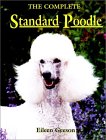
Click on the cover above
to go to this book
at Amazon.co.uk
|

The Complete Standard Poodle
Geeson
Hungry Minds Inc
ISBN: 0876056028
Standard Poodles are the original Poodles, developed as hunting dogs
before they became companion dogs. They tend to be calmer than the smaller
varieties, and are very versatile. This book emphasises the versatility
of the breed, and provides help with training, so that you can make
the best of your Standard Poodle. There is also help with general care,
including nutrition, as well as grooming, and an interesting account
of the breed's history.
 Top of page Top of page
|
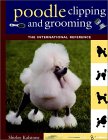
Click on the cover above
to go to this book
at Amazon.co.uk
|

Poodle Clipping and Grooming: the International Reference
Shirlee Kalstone
Hungry Minds Inc
ISBN: 0876052650
This book is a very useful resource for groomers, since Poodles are
important clients of dog grooming establishments. There is help with
different styles of Poodle clips, as well as an account of equipment
used by groomers, with explanations of how the equipment works and opinions
on how useful it is.
 Top of page Top of page
|
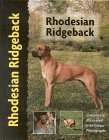
Click on the cover above
to go to this book
at Amazon.co.uk
|

Rhodesian Ridgeback
Ann Chamberlain
Interpet
1902389271
Rhodesian Ridgebacks get their name from the ridge of fur along their
spines. They are hunting and guard dogs, sometimes classed as hounds,
but more territorial than most hounds. As with other natural guard dogs,
it's safer to socialise them as much as possible with people from when
they are pups, with ongoing socialization throughout their lives, so
that their natural guarding instinct doesn't turn into aggression against
people you would rather they were friendly with.
These dogs have the independence of hounds, so they need consistent
training from when they are pups. They also need a lot of exercise.
A Rhodesian Ridgeback which is bored and isolated can be very destructive
in the home. Walks can be a problem because they can become dog aggressive
as adults, even after careful socialization. However, a combination
of socialization, obedience training, and defensive walking, can help
keep the dog out of trouble. Obedience training should include excellent
recall, to be able to call the dog back if he looks like he is planning
mischief, while defensive walking includes avoiding areas where there
are a lot of dogs, especially ones that might plague a Rhodesian Ridgeback
on the lead.
Are they good with children? Not especially. Rhodesian Ridgebacks aren't
very tolerant of being teased or handled roughly. They can get on well
with sensible, older children who understand dogs.
This breed is generally reserved with strangers, and is bold, so is
unlikely to back down if an uninvited visitor comes into your house.
It's important to ensure that this combination of wariness and boldness
doesn't lead to aggression, since the visitor could be a child.
Rhodesian Ridgebacks aren't especially barky, and they don't need a
lot of grooming. They are tough dogs, able to handle big changes in
temperature, but they are likely to develop behavioural problems if
they are left outside alone as guard dogs, and in any case, leaving
them unsupervised in the garden could create problems if they escaped
or a child wandered into the garden.. Common health problems include
hip and elbow dysplasia, hypothyroidism, cancer, bloat, dermoid sinus,
and cysts.
Ann Chamberlain has a long involvement with Rhodesian Ridgebacks, and
has drawn on her experience in producing a book especially suited to
pet owners. The character of this very special breed comes across clearly,
as does her love for Rhodesian Ridgebacks. This guide is clearly written,
so would suit novice Ridgeback owners, and has enough information to
interest existing owners.
 Top
of page Top
of page
|

Click on the cover above
to go to this book
at Amazon.co.uk
|

The Rhodesian Ridgeback Today (The Book of the Breed)
Stig G. Carlson
Interpet Publishing
ISBN: 1860540899
This guide to Rhodesian Ridgebacks is especially strong on the history
of the breed, relating that to the breed's character. There is also
a lot of help with socialization and training, which are important with
this breed, as well as advice on general care, and on choosing pups.
The book gives a very clear idea of what it's like to live with a Rhodesian
Ridgeback. There are also some stunning pictures.
 Top of page Top of page
|

Click on the cover above
to go to this book
at Amazon.co.uk
|

A New Owner's Guide to Rottweilers
Ochsenbein
TFH Publications
ISBN: 0793827507
Rottweilers are very versatile dogs, which have performed a number
of roles, including herding, tracking, hunting, and guarding. They have
also been used by police forces, and can perform well in competitive
obedience. They pay attention and learn fast but can also learn bad
habits very quickly, so their training should be carried out very carefully.
They also need extensive and ongoing socialization from puppyhood and
right through their lives, because of their guarding tendencies. A well-socialized,
well-trained Rottie with a good temperament is a very gentle, stable
and trustworthy dog, despite their reputation.
Rotties should always be socialized to be friendly with strangers -
this is true for any large dog, but especially true for a dog with guarding
instincts that learns fast. Teaching your Rottie to be friendly with
strangers won't hamper his ability to be a guard dog. No intruder is
going to try to get past a Rottweiler even if he or she appears friendly,
and it is difficult to change their ways if Rotties have been taught
to show hostility to strangers. You want a dog which will be friendly
with people you bring into the home. A Rottweiler is always likely to
look serious with uninvited visitors, but it is preferable that he doesn't
bite them, since the visitor could be a delivery man or a wandering
child.
Training should start with teaching the pup not to playbite people,
since teaching bite inhibition is much more difficult with an adult,
and a Rottie that bites can do serious damage. It's important to teach
the pup house rules while he is small enough to manage easily, because
adult Rottweilers are large, strong dogs. They do need exercise and
mental stimulation. You could try, for example, sniffer dog games, or
teach the dog to retrieve when he is a pup. Rotties do have one characteristic
which can be alarming, which is a conversational growl. Normally, a
growl is a warning sign, but Rotties will sometimes growl without evil
intent. Owners will come to recognize the difference between a conversational
and a warning growl, though this can be alarming to someone who does
not know the breed, and just knows of their reputation for being aggressive.
Rotties have a reputation for being dog-aggressive, though much depends
on the temperament of the individual dog, and on whether socialization
with other dogs has been ongoing, starting early. Many Rottweilers are
friendly with other dogs, and enjoy playing with them, but you may find
that, despite careful socialization, your Rottie dislikes other dogs
on walks - especially dogs of the same sex, and if this happens it is
prudent to avoid situations where your dog could get into a fight.
Are Rottweilers good with children? This depends. Some Rottweilers
are excellent companions for sensible children, enjoying their company
and obeying their commands. Much depends on choosing a pup from a line
with a nice temperament, on socializing the dog with children from when
it is a pup, as well as on training. Rotties are large dogs, so they
can knock over small children, and children and dogs always need supervision.
It is not a good idea to have neighbourhood children rushing in and
out of a garden where a Rottweiler is confined, especially a young Rottie,
who could get over-excited and boisterous with a lot of rushing around
and screaming going on.
A Rottweiler with a nice temperament is a very rewarding dog for an
owner with some idea of how to train dogs, because they learn so fast,
and are so versatile. They are not as forgiving of owner mistakes as
are, say, Labrador Retrievers, and the breed does have a strong guarding
instinct, so they are best taken on by people who already have some
experience of dogs. Individuals also vary in terms of temperament, so
this is one reason for taking extra care when choosing a pup. Ask the
breeder what sort of temperament is being aimed for. Another reason
for selecting pups with care is that the breed can suffer from serious
inherited health problems. Common health problems include hip dysplasia,
cancer, heart disease, hypothyroidism, bloat, entropion, Von Willebrand's
disease, allergies, and spay-related incontinence. This breed doesn't
need much grooming, and isn't especially barky.
This is a good introductory guide to Rottweilers, which covers their
early history and general care, including nutrition and health care.
There is also some help with training.
 Top
of page Top
of page
|
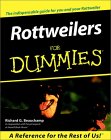
Click on the cover above
to go to this book
at Amazon.co.uk
|

Rottweilers for Dummies (For Dummies)
Richard Beauchamp
Hungry Minds Inc
ISBN: 0764552716
This book is a more in-depth guide to Rottweilers than the Ochsenbein
breed book. There is a lot of information on the history of the breed,
and help with caring for your Rottie at every stage of his life, from
housetraining and general obedience training, to health problems found
in the later years. It is also very good value for such a comprehensive
guide.
 Top of page Top of page
|
|

The New Rottweiler: Essential Reading for Owners,
Breeders and Judges
Jim Pettengell
TFH Publications
ISBN: 0793800803
This is an especially useful book for anyone choosing a Rottweiler
pup, as well as for breeders and judges. It's not a very new book, this
edition came out in the mid 1990s. It does have a lot of information
to help choose a pup, and care for youngsters and adult dogs. The information
on health and disease is especially useful, given that the breed is
prone to a number of health problems.
 Top of page Top of page
|
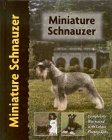
Click on the cover above
to go to this book
at Amazon.co.uk
|

Miniature Schnauzer (Pet Love)
Lee Sheehan
Interpet Publishing
ISBN: 190309853X
Miniature Schnauzers are the smallest of the Schnauzer family, which
also includes Standards and Giant Schnauzers. Miniature Schnauzers are
easier to handle because of their small size, though they are lively
dogs and know their own minds. They are a little like terriers in being
bold, especially with other dogs, and liking to dig and chase and catch
small prey, but they are more biddable than most terriers. Miniature
Schnauzers do need regular walks, or they will tend to get fat and barky.
They like following their noses, but generally have better recall than
most terriers. They can perform well in obedience classes.
Are these dogs good with children? They can do very well in families
with children, because they are active, lively dogs, which like attention
and can keep up with children, so long as they are trained properly
from when they are pups. Their small size does make them a little vulnerable
to young children, so supervision is important.
Miniature schnauzers sometimes have problems getting on with other
dogs. It is not so much that they attack other dogs, but they sometimes
make displays which are seen as aggressive by passing dogs, and which
can get them into scraps. Socialization with other dogs helps, but even
well-socialized Miniature Schnauzers will sometimes get into trouble
on walks.
These dogs can be quite barky, especially at visitors, and when they
want something. This means that they make useful watchdogs, and their
alarm barks can be switched off by praising them for giving you the
alarm call, then asking them to sit. Barking for attention can be discouraged
by simply ignoring them when they bark, and rewarding quiet sits. Miniature
Schnauzers are usually good with visitors, and friendly with strangers
who say hello to them. A hello from a stranger tends to quieten a barking
Schnauzer. Miniature Schnauzers are not especially nippy, but need special
care paid to bite inhibition training just in case, since they can be
pushy when they want something. They don't shed much, but do need attention
to grooming, or they mat. Clipping helps keep their coats easy to manage.
They can get food in their beards. Their usual haircut accentuates their
beards and eyebrows, and shows off their bodies.
These dogs do vary somewhat in temperament, and some are livelier and
bolder than others. It's worth meeting the parents of a pup you are
interested in, to find a temperament that suits you. Common health problems
include kidney and liver disorders, skin disorders and allergies, von
Willebrand's disease, diabetes, cysts, and eye problems.
This is a well-illustrated guide to Miniature Schnauzers, with good
advice on general care, grooming and showing, as well as an interesting
account of the breed's history. You can skip the training advice!
 Top
of page Top
of page
|

Click on the cover above
to go to this book
at Amazon.co.uk
|

Standard Schnauzer, a Complete Guide
Barbara Dille
Hardcover - 96 pages (1 December, 1997)
TFH Publications
ISBN: 0793807565
Standard Schnauzers are the middle size in the Schnauzer range (unlike
Standard Poodles, which are the biggest size!). They are probably closest
to the original Schnauzers which are depicted in old paintings, and
are very versatile dogs which have been used in a variety of working
roles, such as hunting vermin, tracking, retrieving, watchdogging, and
they can also perform well in agility and obedience events.
Schnauzers tend to stay puppish for longer than many breeds, but they
are very trainable, with patience. They are active dogs, which can be
pushy, and need a fair amount of exercise and interesting things to
do if they are to be well behaved. They vary in terms of temperament,
so it's a good idea to meet the parents of pups you are interested in,
and ask the breeder what sort of temperament they are aiming for. Some
are warier of strangers than others, and some can also be quite barky.
Underexercised and bored Schnauzers tend to be barkier than those dogs
which are given something to do. They do need a lot of socialization
with people, especially those individuals which tend to be wary, so
that they are well-behaved with your visitors. Standard Schnauzers are
generally good watchdogs, alerting owners to the presence of strangers,
but are too small to be effective guard dogs, though they can have strong
guarding tendencies.
Do they get on well with children? Standard Schnauzers are generally
affectionate and playful dogs, so they can get on very well with sensible
children. Children need to be brought into training programmes, because
these dogs can be pushy, so that the house rules are enforced by everyone,
and the dog respects the child.
Scraps with other dogs can be a problem, so socialization is very important
for Standard Schnauzers when they are pups, and it should be ongoing.
Schnauzers tend to be quite bold, and will not back down from conflicts
with other dogs They can also initiate conflicts. However many Standard
Schnauzers make friends with dogs of other breeds and play with them
happily.
Like Miniature Schnauzers, Standard Schnauzers are usually given a
classic Schnauzer hair cut which accentuates their beards, left long,
and their strong bodies, where the coat is cut short. .They don't shed
much, but their coats can mat if not groomed regularly.
These dogs tend to stay active even when they are quite old, but they
can suffer from some health problems, such as cancer, hypothyroidism,
eye disorders, allergies and hip dysplasia.
Barbara Dille has written a very good introduction to this lively breed,
which gives a clear picture of the Standard Schnauzer's character and
needs. It's a well-written and well-organized book, which is very well
illustrated.
 Top
of page Top
of page
|

Click on the cover above
to go to this book
at Amazon.co.uk
|

Giant Schnauzer (Pet Love)
Barbara J. Andrews
Interpet Publishing
ISBN: 1902389018
Giant Schnauzers are the biggest of the Schnauzer family, and are
very similar to Standard Schnauzers. They are better suited to being
guard dogs, because of their large size, though they should still be
socialized extensively, so that they behave well with visitors. Giant
Schnauzers are a little more prone to health problems. Common health
problems are similar to those of other Schnauzers, and include hip dysplasia,
hypothyroidism, cancer, skin disorders including allergies, as well
as heart problems and seizures.
This book is a very good guide to Giant Schnauzers, which should interest
experienced owners, as well as those new to the breed. There is help
with behaviour and training, as well as with general care, including
nutrition and health care. The book gives a very clear idea of the Giant
Schnauzer character, and is also well-illustrated.
 Top
of page Top
of page
|

Click on the cover above
to go to this book
at Amazon.co.uk
|

Shar-Pei (Pet Love)
Juliette Cunliffe
Interpet Publishing
ISBN: 1902389441
The Shar Pei has a very odd appearance, with folds of skin round the
neck and face, and very small ears. This breed is similar to the Chow
in many ways, with the same blue-black tongue, and tendency to be aloof
with strangers. Shar Pei have performed different roles, as fighting
dogs, guard dogs, and hunting dogs. Some individuals can be aggressive
with both strangers and other dogs. Much depends on the temperament
of the parents, as well as on early socialization. Some Shar Pei may
also be unable to see well, due to the folds of skin, so they can be
easily startled by unexpected petting. It's especially important to
check the ancestry of pups of this breed, because their temperaments
can vary, and because of the risk of inherited health problems. Some
well-socialized individuals are calm, relaxed and stable, and very good
with children, strangers, and other dogs, while others are much less
trustworthy, despite socialization.
This breed is like the Chow in that owners need to establish house
rules from puppyhood, and take a firm, but gentle approach to training.
Shar Pei will tend to try to get their own way if owners are inconsistent,
so it's important that everyone in the family agrees on the house rules
for the dog, whether climbing on furniture is allowed, for example.
Shar Pei are generally clean dogs, which are easy to housetrain, and
they don't need a lot of grooming. They can be droolers, however. They
need a fair amount of exercise, and owners should be cautious about
encounters with strange dogs, due to the breed's propensity for dog-aggression.
Shar Pei don't like water, let alone swimming.
Common health problems include allergies, cancer, skin disorders, eyelid
trouble, kidney failure, hypothyroidism, hip dysplasia, luxating patella,
and breathing trouble and snoring due to breathing being impaired by
the folds of skin and short muzzle. Shar Pei are also especially sensitive
to anaesthetics, and they tend to suffer on hot days. They need shade
and water, and should be exercised in the early morning and after dusk
when it's very hot.
These are not dogs to choose simply because you like the breed's odd
appearance. They need an owner with commitment, starting off with a
search for a well-bred pup, which can take a lot of time, and then the
extra skill and commitment needed in training a breed that can be difficult.
They are dogs which can repay this commitment with loyalty and affection,
and they do have some advantages, such being clean, and less likely
to bowl over visitors with effusive greetings than some breeds.
Juliette Cunliffe's book is a good, up-to-date introductory guide to
the breed. The history of the breed is covered, as well as general care,
training, and health issues.
 Top
of page Top
of page
|

Click on the cover above
to go to this book
at Amazon.co.uk
|

Dr. Ackerman's Book of Shar-Pei (BB Dog)
Lowell Ackerman
TFH Publications
ISBN: 079382561X
This is a short introduction to the breed, which is especially good
on Shar Pei health problems. It's a good introduction for new or would-be
owners, though experienced owners are likely to find little they don't
already know. The pictures are good. It is also an inexpensive book.
 Top
of page Top
of page
|

Click on the cover above
to go to this book
at Amazon.co.uk
|

The Shar Pei
Ellen Weathers Debo
TFH Publications
ISBN: 0866221549
This is a classic guide to Shar Pei, which gives a lot of information
on the breed's history and on different breeders and kennels. There
is also a lot of useful help with general care of the breed. It's well-illustrated,
and well-written. It's a little out of date to be the only book you
have on Shar Pei, but is fascinating addition to the libraries of people
interested in this breed and its history.
 Top
of page Top
of page
|
|

The Book of the Shar-Pei
Joan McDonald Brearley
TFH Publications
ISBN: 0866226265
This book is an in-depth guide to Shar Pei which is a useful reference
book for novice and experienced owners. It is geared to US readers,
but provides a lot of detail which is useful to readers both sides of
the pond.
 Top
of page Top
of page
|
See also:
 Dogs:
Breed profiles and breed books Dogs:
Breed profiles and breed books
 Dogs:
Health and Nutrition Dogs:
Health and Nutrition
 Dogs:
General Dogs:
General
 Dogs:
Origins, canine evolution and wolves Dogs:
Origins, canine evolution and wolves
 Training, puppy and adult dog good manners Training, puppy and adult dog good manners
 Advanced training, including gundog training Advanced training, including gundog training
 Fiction
and biography relating to dogs Fiction
and biography relating to dogs
 Click
here for other breeds on stamps Click
here for other breeds on stamps
|